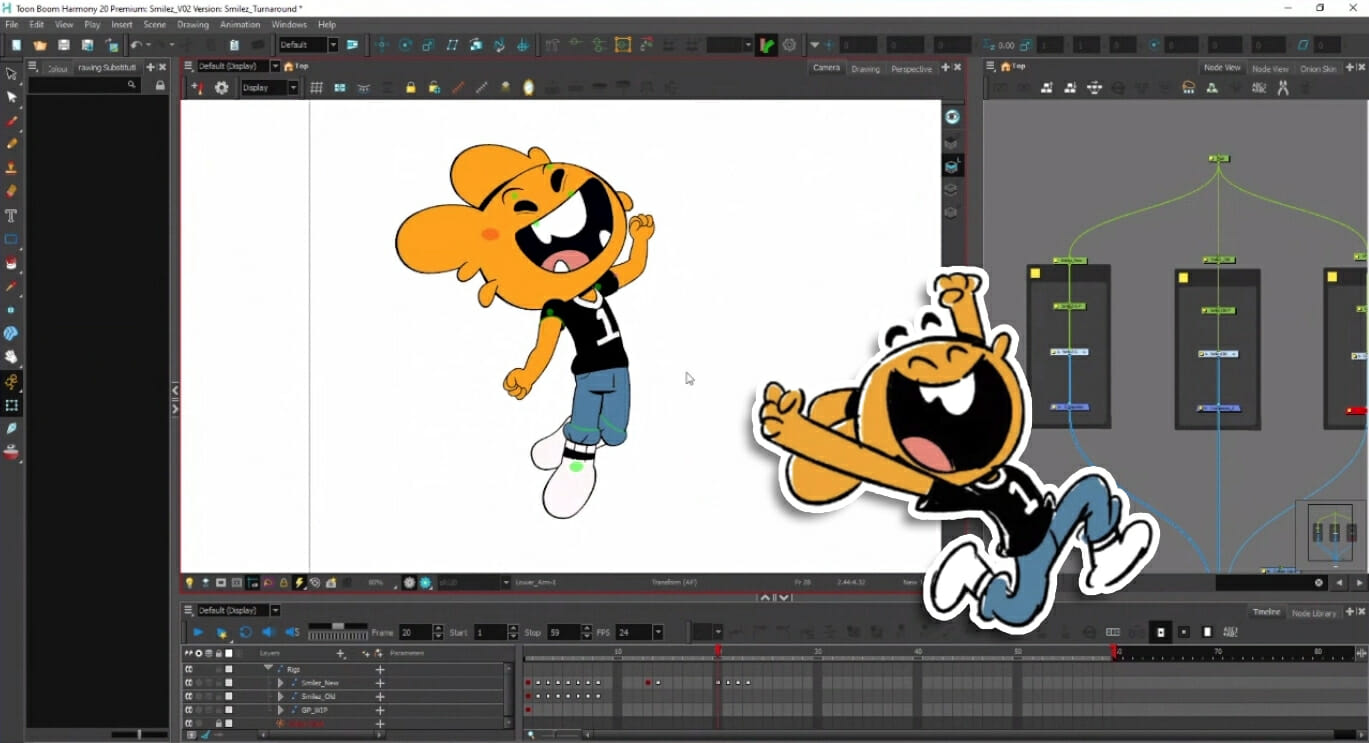
Sample character rigs are extremely helpful for artists interested in the craft of cutout animation or 2D rigging. If you already downloaded every available example file from the Toon Boom Learn Portal, we found something to put a smile on your face.
Jordan Beatty is a rigging artist based out of Ireland. In his spare time, Jordan builds free character rigs, which he shares on his Gumroad page. His latest creation adapts Nic Parris‘ character, Smilez, for cutout animation. This Smilez character rig includes an 8-point turnaround, contains a set of happy, neutral and sad mouth shapes, multiple facial controls, as well as a fully-deformable body. Jordan’s rig works in Harmony Premium and takes advantage of features currently used in production rigs.
We invited Jordan Beatty and Nic Parris onto our livestream to discuss the design and rigging process that went into this character. The conversation includes a walkthrough of the Smilez rig, tips for designing characters with cutout animation in mind, and advice for artists interested in starting their careers in animation. Need to brighten your mood? Watch our full video interview below or read our excerpts from the stream.
Can you tell us how the design of Smilez came about?
Nic: Going through the history, Smilez was supposed to be part of a story I was coming up with called 1 Off. He was originally “1.” I was going to do a neon noir story, so I had him in detective clothes, but he still had the thing where he hates wearing shoes. So he still had socks on. But the more I thought about it, I wanted him to just be this character that brings smiles to everyone. I named him Smilez with a Z.
Doing some more “1 Off” character designs. I gotta come up with some names for these lil dudes!#characterdesign #Smile #Agent #Frog #creatures #one #off #colors #illustration #conceptart #cartoon #Pink #green #orange #logo #walking #tie #process #sketch #digitalart #progress pic.twitter.com/YNVe0MkgBO
— Nic Parris (@NicParris) February 6, 2020
Just so you know, he’s actually a fusion of a bunny and an axolotl. I feel like bunny characters are really popular. And then axolotls are my favorite reptile — or is it amphibian? I always forget which one. So I combined an axolotl with rabbit and gave it extra lumps. What’s always funny is when someone asks, “is it fur or is it flesh?” My answer is yes. That’s basically how I came up with his head shape. If Smilez was ever in silhouette, you could tell by his whiskers and his ear lumps alone that it’s Smilez. That was the biggest challenge for me.
And then with the additional divot in one tooth: I am a big fan of things being asymmetrical. He has two little bottom teeth.
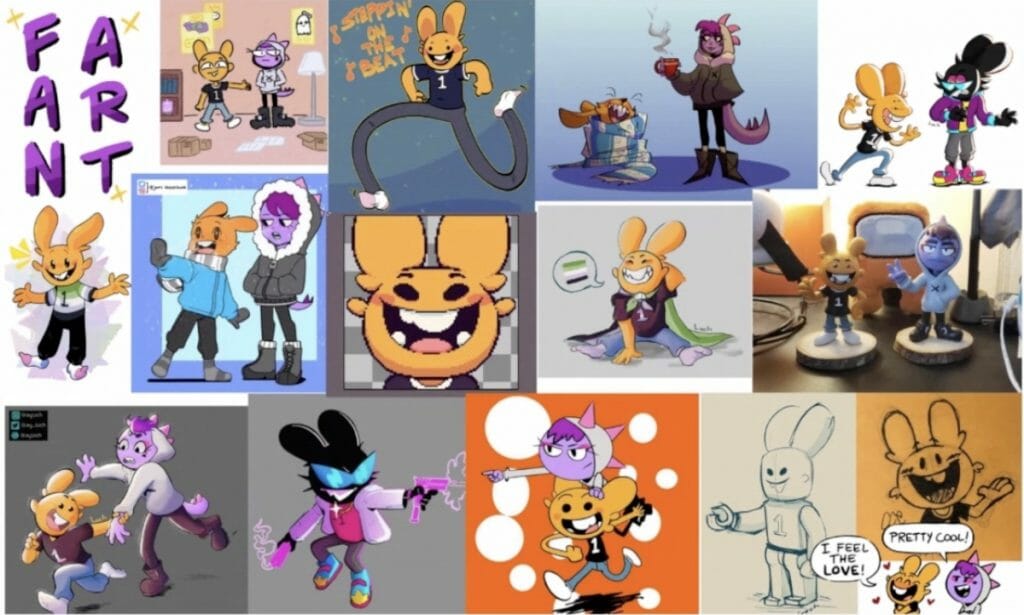
What is your favourite piece of Smilez fanart?
Nic: I definitely like the sculptures, which I have in my apartment. It’s pretty awesome that someone actually sculpted them: They’re actually 3d in real life, so they’re in my apartment now. So I think that’s what I really like the most. Other than that, I have this dancing pixel fanart, which I really enjoy. Seeing him with his full personality in pixel art is like… pixel art never gets old.
Is there anything that you wanted to share on your screen before we switch to Jordan’s screen?
Nic: Just thinking about the big questions I get like, “what do you need if you want to be a professional character designer?” Expression sheets will help your portfolio. Showing you can do a turnaround technically correctly is very important if you want to be a character designer. Even if turnarounds aren’t your favorite thing to do, they are very important. Because when someone decides to rig your character or wants to animate it, it’ll look right.
And, just a quick professional cheat, because everyone thinks you have to draw from scratch: I start with the three-quarter view and I draw on top of it, as I rotate it around. It’s just a quick little turnaround trick a lot of people don’t know. Whenever I made a mistake I was like, “I have to redraw from scratch all the time!” But now you can draw the front view from the third quarter, just shift things over. Because we do lots of digital drawing anyways, take advantage of the platform.
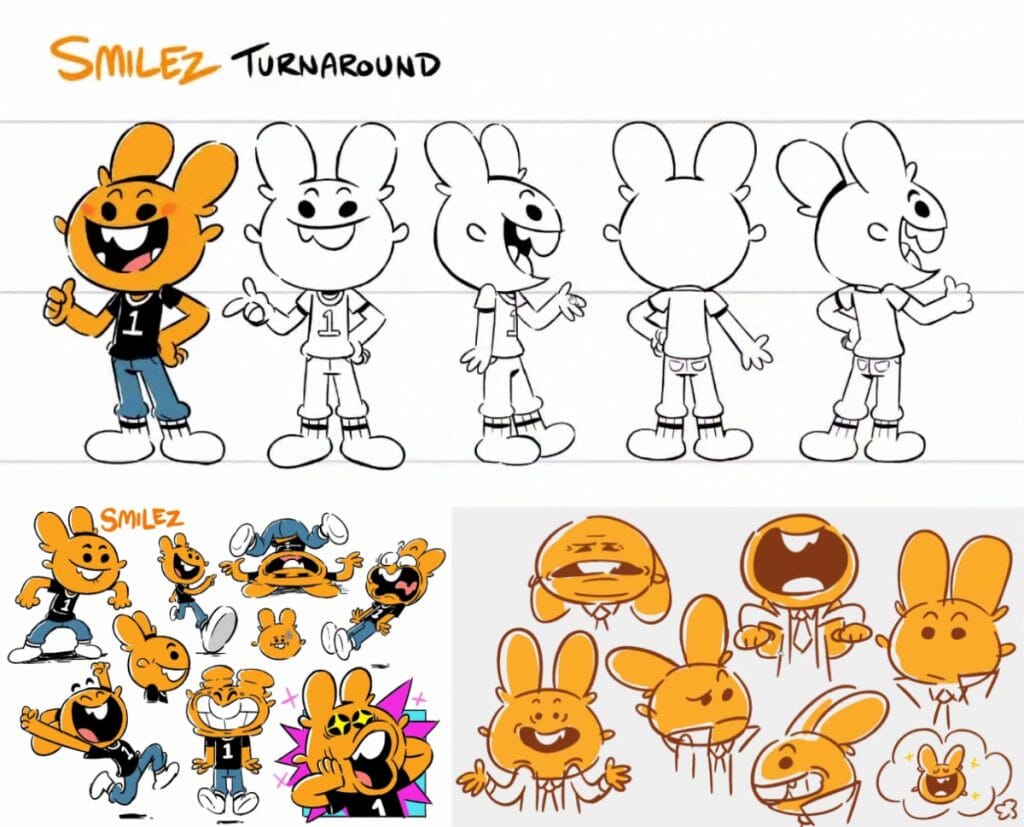
Jordan, how did you first learn about Smilez and what led you to creating this rig?
Jordan: When I originally found this character, I was searching just through the internet: looking for turnaround characters and making a big folder of them. You scroll for ages, and you’re just like, “there’s nothing here that I like.” And it’s really perking up when you see the one that you know, it’s the golden ticket. That was the Smilez turnaround. I went through all of his designs and started looking for more Smilez images, saving them all.
And I just started building it. I originally built it for myself, just to do for a showreel. And then my friend Kasun was just like, “Hey, can I use this for an animation?” And I was just like, “it’s not ready for animation, but I’ll make it ready for you.” So he took it, did an amazing animation. When it was finished it blew up; a lot of people on the internet noticed it. Nic noticed it.
Nic: A tear rolled down when I saw it animated.
A Little animation test i did.
— Kaziger Jay (@KazigerJ) May 30, 2021
character designed by amazingly talented @NicParris
awesome rig by https://t.co/XUsBx6F3cx
beautiful background by https://t.co/RexLmmSBog#toonbom #toonboomharmony pic.twitter.com/UpJbtac1ia
Jordan: So I asked Nic, “Can I make this a professional rig and put it online for free?” And he’s just like, “Sure. Yeah. Totally. Go for it.” So I built it completely from scratch. Just rebuilt it over the month, because by that point, it had been five months since I built the original. And I had a lot more experience rigging.
Nic: So you hit me up: “Is it cool if I rig Smilez?” I’ve had it happen a few times with characters I’ve designed in the past, where someone’s asking if it’s cool if they animate it. And I’m like: “Sure. Just tag me when it’s done, so I could see it and get credit for the original design.”
Honestly, you guys are the first that I saw who completely finished it. Usually I don’t see anything. I’ll never forget, because I was up at, like, 6AM, my time, when I saw it. I was getting tired. I think I was doing late hours. Then I saw it animate and I was awake again.
“This is actually animated? There’s a background? It’s rigged?”
It was surprising. There’s a proud feeling, being a character designer, seeing someone take the time to fully rig your character and animate it, when all you said is: “Yeah, you can use it.”
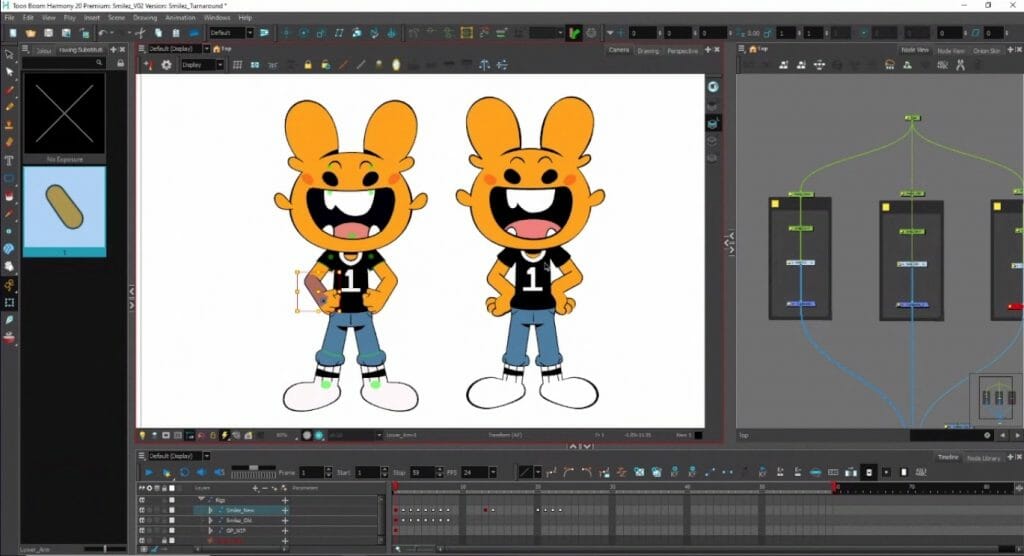
Speaking of the rig: Jordan, can you take us on a tour?
Jordan: The new rig is more refined; built properly for animation. He has articulated fingers, so he can hold the objects properly. The mouth shapes have a whole selection of happy substitutions, and also have neutrals and sads, which I feel won’t get used as much because he’s literally called Smilez. The original was just just flat, so you had like no controls for his face. It doesn’t even have deformers.
And now he’s got properly rigged eyebrows! He has wrinkles on his face. And he has eyelids. Pretty much the whole thing is fully moveable, fully rigged. Even the “1” on his shirt. You can rotate it if you want to get really nice angles; you can stretch it properly and give them a bit of a rotation. I also have controllers for the hand and for the arms. So if this arm is hidden behind his body, you can grab it.
For some of my favourite bits: On his chin, the shadow is a copy of his chin connected by the same deformer — so you never have to move the shadow! It’s just always there, so it is attached. And he has cutters for his sleeves, so there’s always a nice cut into the shirt. You can get these really nice, 3D-feeling kinds of shots, and yet, he’s a very simple character. But you can articulate his arms properly, and they have muscle definition.
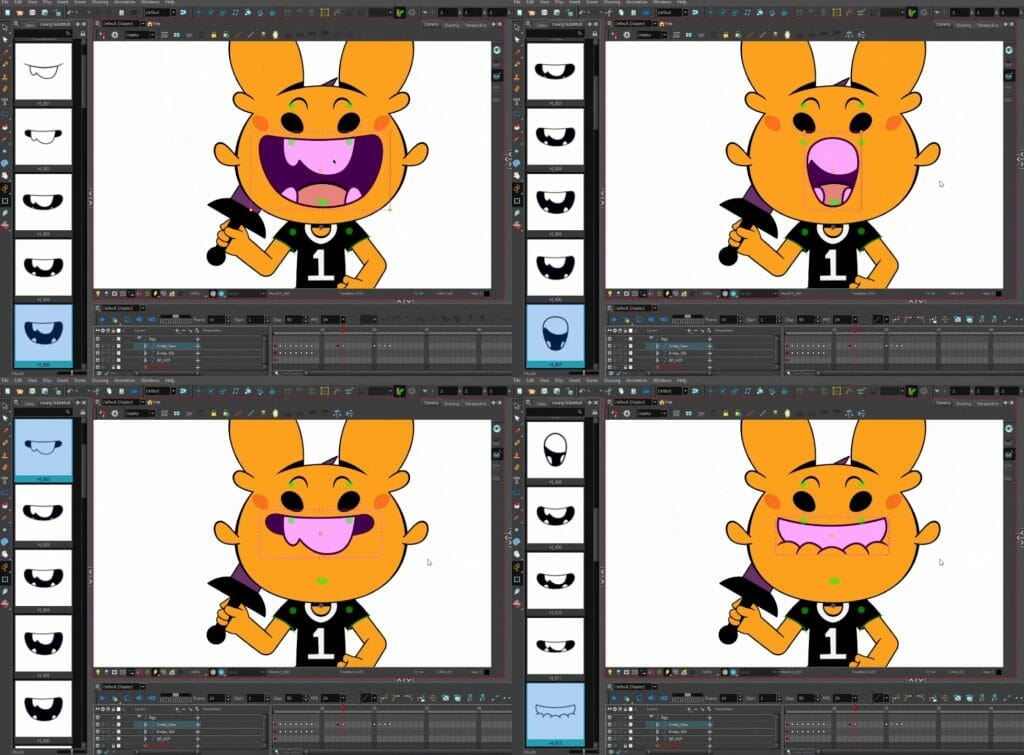
I enjoy all the poses that you ran this rig through. Do you feel like that’s an important part of the rigging process?
Jordan: Definitely. I think one of my supervisors in my studio, at Boulder Media, told me: “Make sure it hits what you need it to hit.” Because what’s the point of the rig, if it can’t do what you need?
That’s why those pose sheets that Nic has, with all of the different expressions, are super helpful. Once you build it, you can go through and build all of these poses. It’s very handy, just to make sure the rig works. You don’t want to give it to somebody who has an amazing idea, which they can’t do because the rig just doesn’t behave properly.
Nic, what kinds of considerations do you keep in mind if you’re designing a character for cutout animation?
Nic: It’s funny because I started as a Flash animator. So it’s built within me. Usually when I am designing characters, I wouldn’t want to have any kind of cloak where it’s on the shoulders, because you would constantly have to deform the cloak. I know Harmony can do that better, but back in my day I would try to specifically design any type of clothing to not be over a joint, like the arms or legs. I also keep in mind rotation of the arms, legs, or the torso as much as possible, without it breaking, just with design alone.
With rigging in mind, I prefer to keep the character simple. And then you could push it later for special poses. That’s why Smilez himself is such a simple design. I definitely try to give the characters enough headspace for the mouth, to be as big as I’d like it to be, without having to break the skull or the head shape. Unless I do want that cartoony look, or stretch and squash the head, which I think I do more these days. That’s what I think about to this day because I have done rigs myself.
I worked in small studios for eight years. Being in small studios, you have to do everything. So I’ve literally done everything required to make a cartoon. I was an animator, a character rigging artist, a director, storyboard artist. I did backgrounds and I’ve composited. If someone was like, “Nick, you need to make a cartoon,” I can make a cartoon. But I know how many people it takes, so I would never say, “I’m gonna make a cartoon.”
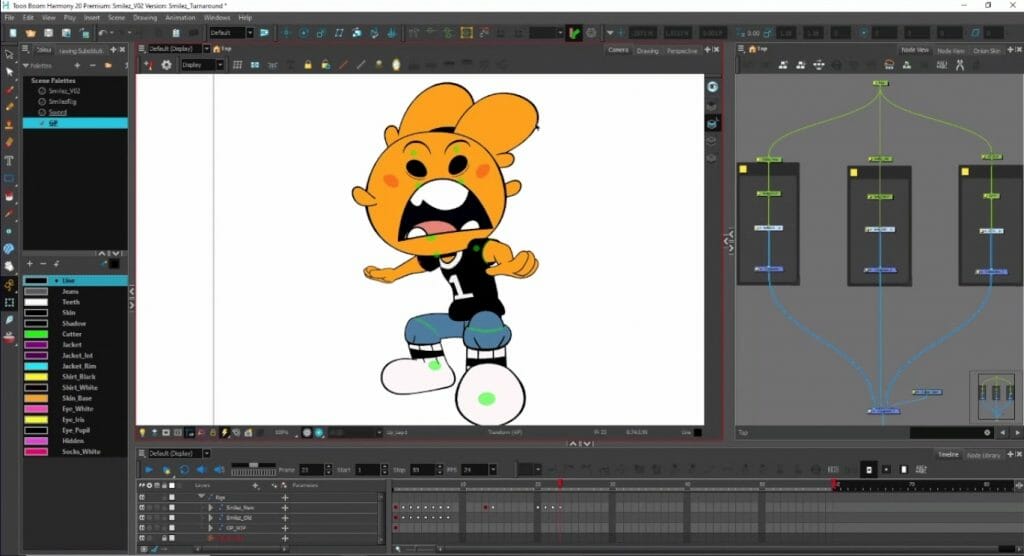
How long did the current version of the Smilez rig take to make?
Jordan: I think the original took, maybe five hours. It was extremely quick to make. The new version took maybe 15 to 20 hours altogether. A lot of that was revisions: You build it, and then you do the turnaround, and then you try and move a component, like the arm and it doesn’t work. So then you need to go back and fix it.
And how long did it take to come up with the turnaround and design for Smilez?
Nic: I can usually knock out a turnaround, maybe three to four hours, max. Because I’ll draw the three quarter view, and just draw on top of it and shift over things. Smilez is a simple design. My goal was to have them be simple, but then push the poses, which might take a little longer.
For the poses… Because I actually have to sit down and think about the poses and push them… I think maybe that was a workday? Maybe six to eight hours of me messing around with the proportions for his first posing. I think I did them on-stream. When you hit the stream and draw, your focus is a little more like, “Okay, I gotta keep drawing because people are watching me.”
New rigged animation exercise I’ve been working on in my spare time! I found this super cool rig and I loved the design, so I thought it’d be fun to work with this little fella! Hope you guys enjoy it! Credits on thread, be sure to check out the people behind the rig! pic.twitter.com/KJup3MhmQm
— SenorPacman – 2D Animator (@SeniorPacman) October 26, 2021
Jordan, do you have advice for artists who want to rig their own characters?
Jordan: Stick with it. Don’t get bored. When you start rigging, it’s such a steep hill. It took me like two months to understand what a cutter was and then took even longer to understand how to use it properly.
And now it’s just: What do I need to do? I need to cut this arm. You can do it instantly. It’s a steep learning hill that really annoys you at the start, but it becomes your best friend after a while. It’ll get easier, so don’t lose hope.
Nic, do you have advice for artists who want to design characters?
Nic: Try to find your voice when you’re designing characters. I think a lot of times people get impatient that they don’t have their own style right away. That just comes with time. My style came from a hybrid of working on other shows. If you’re trying to find your own style for character design you can kind of take styles you like and kind of Frankenstein pieces of it together. If you like the eyes of a style here, the shape language of this style there, and combine them, that might help you find your own style.
Just keep drawing. If you’re looking online and see someone who is a better artist than you, don’t get discouraged — let it motivate you. Let it keep pushing you forward and keep progressing. I get this question a lot: “Am I too old to be in animation?” So long as you can draw and get the job done on time, you can be any age to join an animation studio. I’ve known artists, on their first gig, on my show, and they’re almost 40. Everyone has their own pace and path to get to where they’re going.
- Interested in seeing more of Jordan’s character rigs? Find rigs for Smilez and Raf on Jordan Beatty’s Gumroad page.
- Looking for resources on the craft of storyboarding? Find Nic Parris’ Let’s Learn Storyboarding slidedeck on Gumroad.
- Ready to try rigging and cutout animation? Download a 21-day trial of Harmony Premium.



